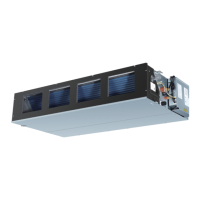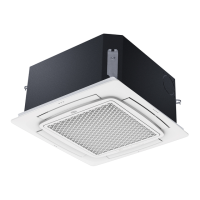1. If the indoor temperature is below the temperature set point
and the humidity is greater than the humidity set point, the
Thermidistat closes circuit R to O, opens circuits R to DH and
R to G, and cycles circuit R to Y/Y2 (for single speed system
R to Y1, or R to Y1 and Y/Y2 for 2-speed system).
The ICM2 motor reads the G signal to the fan coil while the
heat pump is operating, circuit R to Y/Y2 for single speed
system, R to Y1 or R to Y1 and Y/Y2 for 2-speed system,
closed (24 vac). If circuit R to G is closed (24 vac), the
motor will deliver airflow at the full cooling or cooling plus
dehumidify mode requested value. If circuit R to G is open
(0 vac) for super dehumidify mode, the motor delivers
reduced airflow to maximize the humidity removal of the
system while minimizing overcooling.
ELECTRIC HEAT HEATING MODE
1. Thermostat closes circuit R to W/W1, or W2
The fan coil delivers the selected electric heat airflow.
HEAT PUMP HEATING MODE — SINGLE SPEED OR
2-SPEED HIGH
1. Thermostat closes circuits R to G and R to Y/Y2
The fan coil delivers single speed heat pump heating airflow.
2. Thermostat closes circuits R to G, R to Y1 and R to Y/Y2
The fan coil delivers 2-speed high heat pump heating airflow.
HEAT PUMP HEATING MODE — 2-SPEED LOW
1. Thermostat closes circuits R to G and R to Y1
The fan coil delivers 2-speed heat pump heating low airflow.
HEAT PUMP HEATING WITH AUXILIARY ELECTRIC
HEAT
1. Thermostat closes circuits R to G, R to Y/Y2 and/or R to Y1
with R to W/W1 or W2 (and R to O in the case of defrost)
In the event that electric heating is called for by the
thermostat while the heat pump is also operating in either
heating or defrost modes, the motor will modify its airflow
output, if necessary, to provide an airflow which is defined
as safe for the operation of the electric heater during heat
pump operation. That airflow is the greater of the heat pump
heating airflow and the electric heater only airflow.
HEATING MODE — SUPER COMFORT HEAT OPERATION
NOTE: The indoor control used, such as a Thermidistat, must be
capable of providing Super Comfort Heat operation mode and
control must be configured as outlined in its installation instruc-
tions. The system must be installed with appropriate outdoor
temperature sensor. Consult indoor control literature to determine
if control is capable and for configuration instructions. Consult
indoor control instructions and sensor instructions for sensor
installation details.
1. If the outdoor temperature is in the range of 10° to 40°F, the
Thermidistat closes circuit R to Y/Y2 (for single speed system
R to Y1, or R to Y1 and Y/Y2 for 2-speed system) and opens
circuit R to G.
The ICM2 motor reads the G signal to the fan coil. If circuit
R to G is closed (24 vac), the motor will deliver airflow at
the full heating requested value. If circuit R to G is open (0
vac) for maximum heating comfort, the motor delivers
reduced airflow to maximize the temperature and minimize
the draft effect of the heated air leaving the fan coil.
Step 11—Troubleshooting ICM Motor and Controls
High voltage is always present at motor. Disconnect power to
unit before removing or replacing connectors or servicing
motor. Wait at least 5 min after disconnecting power before
opening motor.
The ICM motor used with this product contains two parts: the
control module and motor winding section. Do not assume the
motor or module is defective if it will not start. Go through the
steps described below before replacing control module, Easy
Select Board or entire motor. The control module is available as a
replacement part.
IF MOTOR TURNS SLOWLY:
1. Replace panel. Motor may appear to run slowly if access panel
is removed.
2. It is normal operation to run noticeably slower if G terminal is
not energized in cooling or heat-pump modes.
IF MOTOR DOES NOT RUN:
Turn off power and check the following:
1. Check 5 amp fuse on Easy Select Board.
2. Check for 24vac on SEC1 and SEC2. If no voltage is present,
check transformer.
3. Check all plugs and receptacles for any deformation which
could cause loose connections. Be sure plugs are fully seated.
4. Verify that approximately 230vac is present at motor.
5. Verify low-voltage control signals to motor (See troubleshoot-
ing example). The motor receives its control signals through
the 12-pin plug (PL-1) on Easy Select Board and 16-pin plug
on wiring harness. The combinations of pins energized will
determine motor speed. (See Fig. 17.) See Table 7 for circuit
board low-voltage screw terminals energized and for voltage
present at each pin on 12-pin plug (PL-1). See Table 7 for pin
number on 16-pin plug which should have voltage when Easy
Select Board screw terminals have 24vac.
USE FOLLOWING PROCEDURE TO CHECK CONTROL SIG-
NALS:
Thermostat
1. Remove all thermostat wires from Easy Select Board.
2. Jumper screw terminals (1 at a time): R-G, R-Y/Y2, R-Y1,
R-W1. If motor runs in all cases, thermostat is miswired,
configured incorrectly or defective. If motor runs in some
cases, but not others, continue to check wiring harness and
circuit board.
Wiring Harness
1. Shut off power to unit; wait 5 min.
2. Remove 5-pin plug from motor.
3. Remove 16-pin from motor.
4. Replace 5-pin plug and turn power on.
5. Check for appropriate voltages on 16-pin connector with
screw terminals jumpered. (See Table 7 for values and see
example below.)
If signals check correctly and motor does not run, inspect wiring
harness for loose pins or damaged plastic that could cause poor
connections. If connections are good, either control module or
motor is defective. If proper signals are not present, check circuit
board using procedure below:
14
→
→

